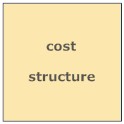 Section
Navigation
Section
Navigation
8. Models and Strategy
8.1 eBusiness in Context: US Scene
8.2 Strategic Management
8.3 Grouping by Strategy
8.4 Business Models
8.5 Customer Segments
8.6 Customer Channels
8.7 Customer Relationships
8.8 Key Resources
8.9 Key Partnerships
8.10 Key Activities
8.11 Value Propositions
8.12 Cost Structure
8.13 Revenue Streams
8.14 Internet Revenue Models
8.15 Strategy
8.16 Company Valuation
8.17 Measures & Ratios
8.18 Fundamental Analysis
8.19 Efficient Markets
8.20 Neoclassical Economics
 8.12
Cost Structure
8.12
Cost Structure
The Cost Structure describes all costs incurred to make a business model
work. Such costs can be calculated relatively easily after defining Key
Resources, Key Activities, and Key Partnerships.
 |
Costs are minimized in every business model, but low Cost Structures are more important to Wal-mart, for example, and 'no frills' airlines. It's therefore helpful to distinguish between two broad classes of business models: cost-driven and value-driven (with many business models falling between these two extremes). |
Cost-driven business models minimize costs wherever possible, often through a low price Value Propositions, maximum automation, and extensive outsourcing.
Value-driven
Value-driven companies focus on a premium Value Proposition, often with a high degree of personalized service. Designer clothes, luxury hotels and asset management fall into this category.
Cost Structures also have the following characteristics:
Fixed costs
Costs remain the same regardless of the volume of goods or services. Examples are salaries, rents, and maintenance in factories, restaurants and leisure facilities.
Variable costs
Costs vary in proportion to the volume of goods or services. Music festivals are one example, as are hosting services.
Economies of scale
Costs per unit output fall as output expands. Mining and manufacturing companies belong to this category — usually to a certain level, when increasing scales bring their own technological problems.
Economies of scope
Larger companies may enjoy a wider scope of of mutually-supporting operations. Amazon, for example, was able to use the technology developed for Internet selling of books and other goods to offer cloud computing services at competitive prices.
Relevant Case Studies
Skype uses the Internet and does not have to manage its own network.
Early dotcom companies spent more on advertising than profits warranted.
OpenTable used the Internet to bring preexisting services together.
Apple adjusted its prices for the iPod as new models were made available.
Halberd Engineering divided into two companies with different cost structures.
Netscape was an innovative company but its cost structure soon became unviable.
 Questions
Questions
1. What are cost structures?
2. Describe six types of cost structure.
3. Describe the advanced web technologies that maintain competitiveness.
4. Describe in some detail a relevant case study.
 Sources
and Further Reading
Sources
and Further Reading
1. Business Model Generation: A Handbook for Visionaries,
Game Changers, and Challengers. by Alexander Osterwalder and Yves Pigneur.
Wiley 2010.